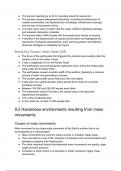Summary
9.2 Hazardous environments resulting from mass movements -CIE A-Level Geography summary (9696)
- Module
- A level Geography
- Institution
- A Level Geography
This summary follows the CIE 9696 syllabus and focuses on Chapter 9.2 specifically. The document contains all the information the exam board could ask candidates about hazardous environments resulting from mass movements, such as: The Causes of Mass Movements Shear stress and Shear strength How ...
[Show more]



